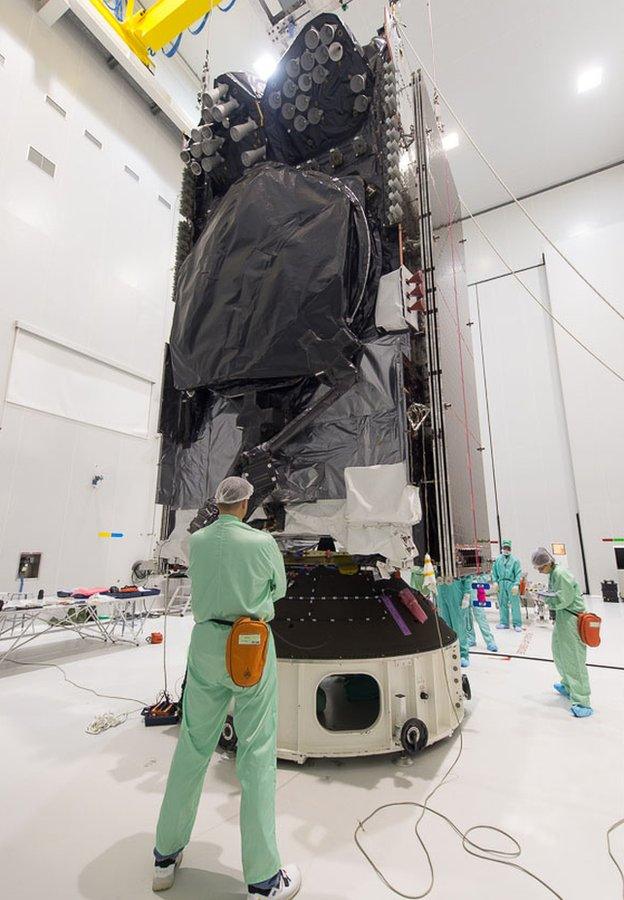Intelsat rolls out Epic next-gen satellite system
- Published

The Ariane rocket left the Kourou spaceport in French Guiana at 23:20 GMT (Wednesday)
Commercial satellite giant Intelsat has launched the first of its new Epic telecommunications spacecraft.
The high-throughput platform should provide customers with superior connections at a lower cost.
Designated Intelsat 29e, it will sit at 50 degrees west, and deliver services to the Americas and the North Atlantic aeroplane and shipping routes.
At least six more Epic spacecraft will follow, to cover other regions and to provide back-up.
Commentators and analysts see the success of the fleet as critical to the fortunes of Intelsat, which is based in McLean, Virginia, and is battling to hold its ground in a fiercely competitive market.
At 6.5 tonnes, Intelsat 29e is a heavyweight "bird", and was the only passenger on its Ariane launch rocket, a vehicle that normally puts up two platforms at once.
All the major commercial satellite operators are in the midst of introducing next-generation systems.
The 29e has substantially enhanced capability compared with Intelsat's previous spacecraft, delivering a throughput of 25 gigabits per second.
Stephen Spengleris is the CEO of Intelsat: "Intelsat 29e is the first of our Intelsat Epic high-throughput satellites. Its entry into service starts the first phase of establishing a high-performance overlay for our global fleet. And more importantly, it allows us, our partners and our customers, to deliver broadband services that will impact the lives of millions of people around the world."
Internet on wings
The satellite will be used for all manner of data connections, from broadband access in remote areas to machine-to-machine communications - the so-called "Internet of Things". Media companies will use Epic to transmit video channels, and telcos will route backhaul traffic through 29e from their cellphone networks.
Special antennas are being developed that will allow even motor cars to talk to the Epic system.
But two key areas of business will be the aeronautical and maritime sectors. Providing connectivity to planes so that passengers can surf in their seats has become a booming business.
The footprint of 29e will cover the region of the North Atlantic with the densest traffic.
Panasonic Avionics, one of the big players in inflight entertainment, was one of the first customers to buy capacity on the new satellite.
Epic's pursuit of aeronautical and maritime business brings it into very direct competition with Inmarsat of London which has traditionally dominated in satcom services to mobile users.
Inmarsat has recently launched three spacecraft in its own high-throughput system called Global Xpress. Unlike Epic, which operates in the C, Ku and Ka portions of the radio spectrum, Global Xpress is concentrated solely on the higher frequency Ka-band.
The Intelsat approach would minimise disruption to customers, commented Rachael Villain from the space consultancy Euroconsult, based in Paris.
"Intelsat have taken the view that they want to maintain backwards compatibility for their customers using their exiting fleet. They have anticipated that the transition to new reception equipment - whatever it is, aeronautical or maritime - would take more time or would be more costly with Ka-band than with Ku," she told BBC News.
The next Epic satellite, Intelsat 33e, which will serve Europe, Africa, the Middle East, and Asia, should launch later this year.

At least six other satellites will follow Intelsat 29e in the Epic series
Jonathan.Amos-INTERNET@bbc.co.uk, external and follow me on Twitter: @BBCAmos, external